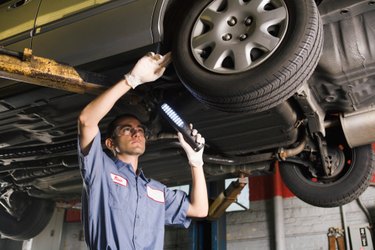Things You'll Need
Wheel chock
Floor jack
Lug wrench
Air compressor
Tire pressure gauge

The rear differential of a Ford Crown Victoria supports the weight of the car and transfers the engine power to the road. The rear end consists of a complex arrangement of gears and axles that seldom need any maintenance. However, the rear end will often make noise when it is going bad, and if you can determine what the noise is and what it means, this can save you from unnecessary repairs.
Step 1
Drive the vehicle on different road surfaces. Rough concrete, asphalt and dirt all make different sounds when driven across. Driving on a different type of road can quickly show if the road surface is the cause of the noise. Road noise will not change if the car is accelerating, decelerating or coasting.
Step 2
Rotate the tires from front to rear and road test the car to see if the noise changes. Tire noise may be mistaken for rear axle noise even though the noisy tires may be located on the front. Check the tires for contact with the car body. Tires that are unevenly worn may produce vibrations that seem to originate elsewhere on the car. Temporarily inflate the tires to 50 psi and test drive the vehicle. Tire noise will be altered by the increase in tire pressure, while rear end noise will not. After testing, reduce the tire pressure to the manufacturer's recommendation.
Step 3
Check the front wheel bearings for noise. Loose or rough front wheel bearings will cause noise that may be confused with rear end noise. Test drive the vehicle and lightly apply the brakes while holding the car speed steady. If the noise is reduced or goes away, then the front bearings may need to be replaced.
Step 4
Place the car in neutral and apply the parking brake. Start the engine and run the engine speed up and down while listening for noises. If a similar noise is produced with the car parked, then it may be caused by the engine or transmission and not the rear axle.
Step 5
Test drive the vehicle. With the vehicle coasting, shift into neutral and listen for noises. If the rear end produces a vibration or growl that continues with the car coasting and the transmission in neutral, the rear bearings are suspect. A bad wheel bearing will cause a knock or click about every two revolutions of the rear wheel.
Step 6
Park the car and chock the front tire. Jack up one rear wheel at time. Rotate the tire by hand and listen for grinding, squeaking or popping noises coming from the wheel bearing. A bad bearing can be felt with the bare hand as a rough resistance to the turning of the wheel. Remove the rear wheel and inspect the brakes for proper operation. A broken or worn out rear brake can be mistaken for rear end noise. Put the rear wheel back on the car and tighten the lug nuts properly. Lower the car off the jack and remove the wheel chock.
Step 7
Test drive the vehicle again. A continuous low pitched whirring or scraping noise starting at a low speed and continuing up to highway speed indicates a bad pinion bearing. A rough or irregular noise that varies in tone and speed during acceleration and while maintaining a steady speed indicates bad differential or pinion shaft bearings. Crunching or popping noises while turning at low speeds indicates a failed ring or spider gear.
Step 8
Drive the car at highway speeds. A body boom noise or vibration can be caused by an unbalanced or bent drive shaft. Visually inspect the drive shaft for damage, missing balance weights, foreign matter or loose universal joints. Repair or replace the drive shaft as required.
Tip
An assistant or helper makes listening for noises much easier. One person can drive the car while the other listens for the type and location of a noise.